No One Left Behind and the Young Person's Guarantee: implementation evaluation
The evaluation explores how effectively No One Left Behind and the Young Person’s Guarantee had been implemented, the experiences of service providers and service users, and lessons from early delivery. The evaluation took place between May and December 2022.
4. Experiences of stakeholders and staff
Key Findings
No One Left Behind
- General awareness of No One Left Behind was high amongst staff delivering employability services.
- Most staff agreed that the services they delivered aligned with No One Left Behind principles, even when they were not fully aware of the details of the strategy and its aims.
- Most employability staff who responded to the survey agreed that No One Left Behind had made at least some positive difference to service delivery in their area, although one in every four did not know if it had.
- Staff identified some examples of positive changes resulting from No One Left Behind included: greater local decision-making; increased partnership working; development of new services; less duplication of service delivery; and increased communication between the local authority and service providers.
- Feedback from employability staff suggests scope for further improvement in partnership working at the local level and ensuring that employability services are easy for people to navigate.
- Of those staff who thought that No One Left Behind had made a positive difference, most thought that No One Left Behind had enabled more people to be supported and had made employability services easier for people to navigate.
- Key barriers identified by staff to implementation of No One Left Behind related to administrative burden and resourcing challenges, including frontline workers feeling under time pressure or under-staffed.
- Employability staff expressed some frustration at the current funding processes and timescales, which were limiting their ability to plan longer term and creating pressure to allocate available local funding at pace.
Young Person's Guarantee
- Awareness of the Young Person's Guarantee was higher amongst employability staff than No One Left Behind and it was found to have been embedded within the wider landscape of employment support services in most areas.
- Most employability staff thought the Guarantee had made a positive difference to the way employability services were being delivered to young people in their area and that it was the right response to mitigating the impact of the pandemic on young people's progression.
- Examples of positive changes identified by staff from the Guarantee included: more employer engagement, the creation of additional training opportunities, more flexible, person-centred support and improved partnership working at the local level.
- Employer Recruitment Incentives were found to have been generally well received by employers, although some stakeholders were less convinced of the need for these in the current climate where many employers are struggling to recruit.
4.1 Introduction
This chapter reports on provider experiences of the early delivery of No One Left Behind and the Young Person's Guarantee based on findings from interviews with local stakeholders and the survey and focus groups with employability staff. It begins with staff experiences of No One Left Behind covering awareness of the strategy and perceptions of the difference it has made. This is followed by discussion of staff experiences of the Young Person's Guarantee, also covering levels of awareness and views on the difference this has made to services. The final section reports on employability staff views on the difference No One Left Behind and the Young Person's Guarantee has made to engagement with service users.
Throughout this chapter, the term "staff" is used as a catch-all to refer to:
- Management: local authority employability leads and others involved in the design and management of employability programmes in local areas
- Frontline staff: key workers, employability support workers and others who work directly with service users
- Work / Careers coaches
- Employer engagement leads
- Training providers.
Where findings relate to a specific group, such as 'management', these are highlighted in the text.
4.2 Experience of No One Left Behind
Awareness of No One Left Behind
General awareness of No One Left Behind was found to be high amongst staff who participated in the survey, although many said they were not fully aware of the details of the strategy and its aims. Around half of those surveyed were fully aware of the details of the No One Left Behind strategy and its aims and a similar proportion were aware of it but not in detail (Figure 4.1). A relatively low proportion (3%) were not aware of No One Left Behind.

Source: Ipsos survey of employability staff
Base: 172
Awareness was highest amongst staff who were in management roles, with two-thirds (66%) saying they were fully aware of the strategy and its aims compared to 47% across all respondents. Third sector staff were significantly more likely to say they were not aware of No One Left Behind, although this was still a low percentage (7% relative to 3% across all).
Most of the employability staff who participated in focus group discussions had heard of No One Left Behind, and had some general awareness of this, but again most were not able to fully articulate the details of this. That said, when asked about their understanding of No One Left Behind, staff frequently referenced features that were in line with the key aims and objectives of strategy such as: improving outcomes; equity; partnership working; targeting support at those who need it most; supporting successful transitions into work; providing access to wider support (such as wellbeing); and taking a person-centred approach.
"I do find it a little bit of confusing, some of the terminology and what sits within what. But my understanding of it as an overarching strategy is it's about supporting people who have barriers to employment to overcome those barriers…But I couldn't tell you the key objectives."
(Focus group participant)
There were mixed experiences amongst employability staff as to how detailed communication about the strategic aims and objectives of No One Left Behind had been. Whilst some had received a lot of communication about this and attended various meetings where this was discussed in detail, others were given more operational level detail focussed on contract delivery requirements. There was limited awareness amongst focus group participants of the No One Left Behind Customer Charter and Service Standards.
"[Staff member] kind of coordinates everything and keeps us in line…now we've got the local employability partnership, there's been a lot of meetings and a lot of communication over that and the differences and the aims and the strategies and such. So, certainly of late there's been quite a lot of communication over No One Left Behind…"
(Focus group participant)
"I mean, there's been communications but it's not been in massive detail. It's more around, 'Here's the programme we're releasing, and here is what the eligibility will be, and here's what we're wanting to do with it,' But not in depth, contract level background detail."
(Focus group participant)
In terms of other local stakeholders, third sector delivery partners emphasised equity, local decision-making, person-centred approach and targeting the most vulnerable as key features of No One Left Behind. Employers were generally not aware of the detail of the strategy.
Changes due to No One Left Behind
Most employability staff thought that No One Left Behind had made at least some positive difference to service delivery in their area. More than half (58%) thought that No One Left Behind had made a positive difference, with one in every three (33%) saying it had made a 'fair amount' of positive difference. Around one in every ten said it had either made no difference (8%) or had made a negative difference (8%). These findings further suggest a general lack of awareness of the detail of the strategy amongst staff delivering employability services, with one quarter (25%) saying they didn't know if it had made a difference in their area (Figure 4.2).
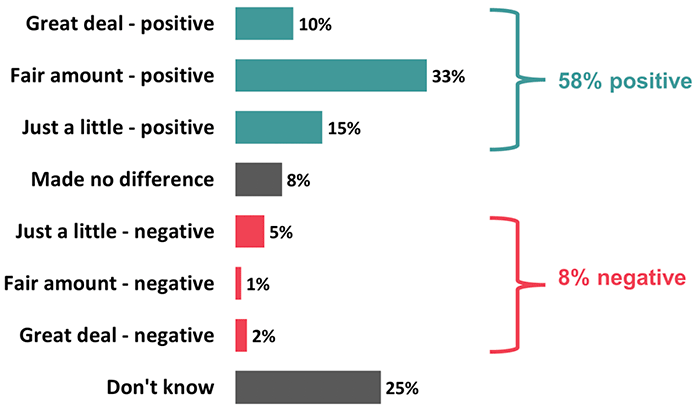
Source: Ipsos survey of employability staff
Base: 172
Local authority staff who completed the survey were significantly more likely to say the strategy had made a positive difference (76% compared to 58% across all respondents). In terms of job role, management staff who completed to the survey were significantly more likely to say it had made a negative difference (26% relative to 8% across all).
The qualitative interviews and focus groups with employability staff explored the ways in which No One Left Behind was perceived to have made a difference to service delivery in their local authority area. Examples provided of positive changes introduced because of the strategy included: greater local decision-making; increased partnership working; development of new services; less duplication of service delivery (because the local authority had more oversight of how funding was allocated); increased communication between the local authority and service providers; and easier for employers to take on staff. In addition to benefits already observed from these positive changes, staff also discussed how they would act as building blocks for future improvements to service delivery.
The extent of difference made by No One Left Behind varied between local authority areas depending on how well developed their existing local employability partnerships and infrastructure were. Some local stakeholders felt that change as a result of No One Left Behind had been less noticeable in their area as in others because they had already been delivering services in line with the strategy.
"I see [progress towards aims of No One Left Behind] more in other areas than my own because I think we already had a single service. I think the difference nationally is that lots of areas never really evaluated what they needed to do next. I see lots of areas now having to align with the frameworks that are there, and to answer questions that point out where their gaps are, and what they need to do. We always did that."
(Local authority stakeholder)
Most employability staff agreed that the services they delivered aligned with the No One Left Behind principles. Almost all of those who responded to the survey agreed that the services they delivered were based on dignity and respect; focused on finding solutions for people; person-centred; and flexible (Figure 4.3).
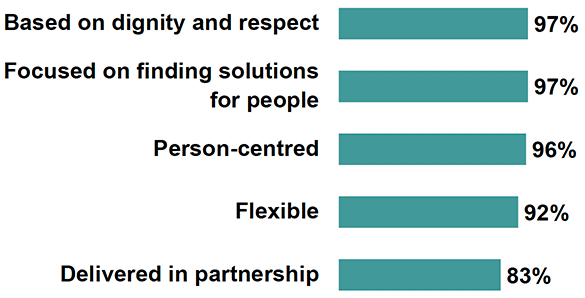
Source: Ipsos survey of employability staff
Base: 172
Responses could be provided on a 5pt scale ranging from Strongly agree, Agree, Neither agree nor disagree, Disagree or Strongly Disagree
A lower proportion (83%) agreed that their services were delivered in partnership, suggesting that there is potentially some scope for improvement on this measure. Looking more closely at this issue, local authority staff who completed the survey were significantly more likely than third sector staff to agree that services were delivered in partnership (91% compared to 77%).
Staff thought that No One Left Behind had made a positive difference to most of the key principles that underpin the approach. Of those who felt the strategy had made a positive difference overall, most thought it had made at least some difference to enabling more flexible, person-centred support (90%); more people to be supported (86%); and improved partnership working (84%). The majority also thought that No One Left Behind had made a positive difference to improving equality of service provision and making employability services easier for people to navigate, although the proportions were lower at 75% and 69% respectively. One in five (19%) thought that No One Left Behind had made hardly any or no difference to improved equality of service provision and around one quarter (23%) thought it had made no difference to making employability services easier for people to navigate (Figure 4.4).
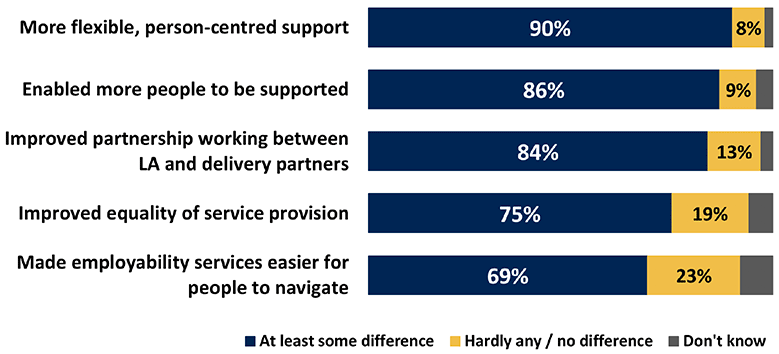
Source: Ipsos survey of employability staff
Base: 96 respondents who think No One Left Behind has made a positive difference
Responses could be provided on a 4pt scale ranging from To a great extent, To some extent, Hardly at all or Not at all
These findings align with feedback from interviews and group discussions with stakeholders and delivery staff, who described ways in which their services aligned with No One Left Behind principles, even when they were not fully aware of aims and objectives of the strategy. The following quote illustrates perceived changes in service delivery relating to partnership working and ensuring person-centred and solutions-focussed services.
"I think we very much worked on our own and I think the providers all worked on their own. I think now, with the introduction of No One Left Behind, we work a lot more closely with each other…it's about the individual and not about, 'Well, that's your programme and we need to give you 12 people to fill it whether they're suitable or not.'...it's, 'What does this individual need?' And we're actually having those discussions…"
(Local authority stakeholder)
Barriers to service delivery
Employability staff highlighted administrative burden and resourcing constraints as key barriers to delivery. The majority (71%) of those who responded to the survey thought there was too much administration associated with their employability services and that this was acting as a barrier to delivery. Most (61%) also felt under time pressure and half (50%) said they were under-staffed. A relatively low proportion (22%) through their services were lacking strategic vision (Figure 4.5).
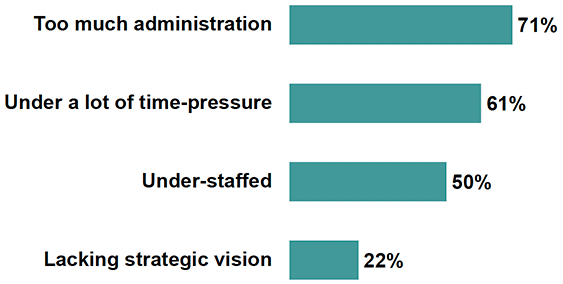
Source: Ipsos survey of employability staff
Base: 172
Responses could be provided on a 5pt scale ranging from Strongly agree, Agree, Neither agree nor disagree, Disagree or Strongly disagree
Qualitative feedback from stakeholders and employability staff also highlighted the administration burden associated with service delivery as being a key challenge, specifically the requirements on local authorities around monitoring and reporting to the Scottish Government. The consensus was that the administration associated with service delivery was time consuming. One local authority stakeholder described how the time they spent collating and organising data could justify recruitment of a full-time staff member. Another noted that whilst the Scottish Government had been receptive to feedback on streamlining requirements, there were frustrations with how often changes were made to monitoring requirements and the time it takes to implement these.
"[delivery partners] have to put in all of the clients that they're working with and then we run the reports at the end of every quarter. But it still takes a good two weeks' worth of work just to go through the entire spreadsheet and address any gaps or chase things up. It is very time consuming."
(Local authority stakeholder)
A further administrative challenge highlighted by delivery staff related to the volume of data that needs to be collected from service users to register for the service. This has been further exacerbated by the fact that local authorities are still managing services delivered under remaining European Union, which have different (and more demanding) requirements to No One Left Behind in relation to the data that needs to be collected from service users at registration. Further administrative challenges relating to registration of service users included: challenges getting ID documents for some young people, such as a bill or bank statement, and a concern that the number of questions asked can be intrusive and deter people from accessing services. There was no suggestion that these were 'new' challenges resulting from the introduction of No One Left Behind, rather they were general challenges faced in the delivery of employability services. One local authority has taken a two-step approach to collecting monitoring information to help build trust with clients.
"We're actually going to move to a different process. We'll still capture all the information that Scottish Government are looking for, but speaking to my key workers, a lot of them are like, 'I'm not filling that out, because that'll just put people off. I only want to help with a CV.' So we're just going down the route of a simple registration form, and then as the clients build up the relationship with their key workers, they'll collect the rest of the information and update as they go."
(Local authority stakeholder)
Local authorities and employabiltiy staff expressed some frustration at the current annual funding processes and timescales, which were limiting their ability to plan longer term and creating pressure to allocate funding at pace. In one smaller local authority, this was linked to staffing challenges where delivering at pace was "a huge burden on the department and on individual members of staff". Longer term funding would also be appreciated by some stakeholders to provide certainty over future service delivery.
"If they really are wanting to give autonomy in locally-based services, then you need time to plan. I feel as if a lot of the funding has come in and has just gone out too quickly, 'Get it spent,' rather than really being able to commit to say, 'Right, what do we really want to fund long term to make a difference in this area?'"
(Third Sector stakeholder)
Stakeholders and staff also mentioned wider barriers to service delivery including: the impact of the pandemic (on ability to deliver services, and on clients); a tight labour market meaning that those presenting for support are typically those furthest away from the labour market or facing entrenched barriers; and adapting to changes in the level of funding received.
There were mixed levels of awareness and levels of engagement with the Shared Measurement Framework[8] for No One Left Behind. Whilst it was found to be embedded in the work of some local authorities, in others it was viewed as time consuming to administer and introduced too quickly. Larger local authorities with more resource and capacity were typically engaging with this more, whilst smaller areas were finding it more challenging to fully embed.
"I think the shared measurement framework is a lot of work for a small local authority. I could put an entire member of staff just continually reviewing how we're doing against this, but I don't have the time to do that. I think it's a great concept and a great idea, but it's too much, too late and should have been planned…"
(Local authority stakeholder)
"Well, that's pretty much at the heart of everything that we're doing and some of us are involved in different working groups around No One Left Behind and a couple of us have been involved in the data and reporting group and it's worked well. We're always saying, 'Right, if you want that bit of data you need to tell us how or you need to work out how it works for answering the questions in the shared measurement framework.'"
(Local authority stakeholder)
4.3 Experience of the Young Person's Guarantee
Awareness of the Young Person's Guarantee
General awareness of the Young Person's Guarantee was higher than No One Left Behind. More than half (55%) of staff responding to the survey were fully aware of the Guarantee and a further third (35%) were aware of it but not in detail (Figure 4.6).
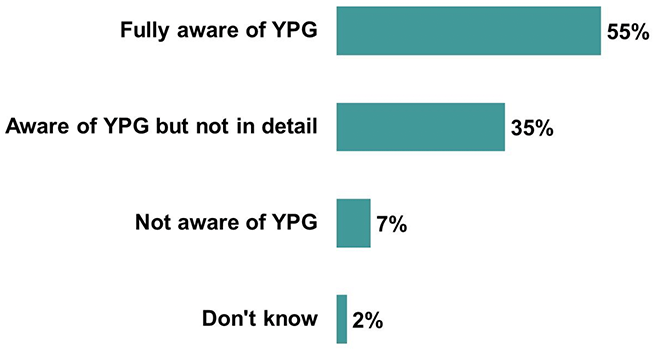
Source: Ipsos survey of employability staff
Base: 172
Management staff were significantly more likely to say they were fully aware of the Guarantee (80% relative to 55% across all respondents), while third sector staff were significantly more likely to say they were not aware of this (12% relative to 7% overall).
In most areas, the Guarantee was found to have been embedded within the wider landscape of employment support services. However, there was some variation between local authority areas in the extent to which the Guarantee was viewed as separate to No One Left Behind or part of the same overall offer. In some areas, the two were very closely aligned, whilst in others they were treated separately.
"I don't think we can differentiate between No One Left Behind and YPG here. The same organisations are being funded through both. We've got key workers in place through YPG as well, so it's very much the same working together for every client, really."
(Local authority stakeholder)
"To be honest they don't really sit together, although they've been operating in tandem to the Scottish government, they came from two different funding directorates. We were able to use No One Left Behind to support Young Person Guarantee delivery, but not the other way around if that makes sense."
(Local authority stakeholder)
Changes due to the Young Person's Guarantee
Most employability staff thought the Guarantee had made a positive difference to the way services were being delivered to young people in their area. The majority (72%) of those who responded to the survey thought it had made a positive difference and just 6% thought it had either made no difference or a negative difference. However, as with No One Left Behind, there was a lack of awareness amongst some frontline staff with a fifth (20%) saying they didn't know if it had made a difference (Figure 4.7).
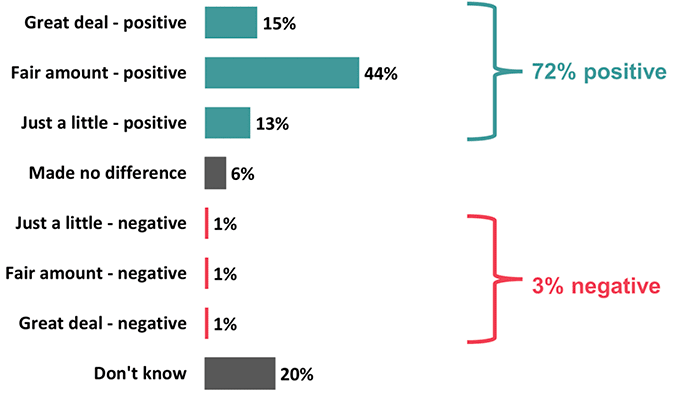
Source: Ipsos survey of employability staff
Base: 156 respondents who were aware of Young Person's Guarantee
Local authority staff were significantly more likely to say Young Person's Guarantee had made a positive difference to the way services are delivered (81% relative to 72% across all).
Of those staff who thought the Guarantee had made a positive difference overall, most thought it had made a positive difference across a range of factors relating to the aims and objectives of the Guarantee. Most thought it had enabled more employer engagement, the creation of additional training opportunities, more flexible, person-centred support and improved partnership working at the local level. Most (76%) also thought it had enabled more use of ERIs, although 15% did not know if it had made a difference to this suggesting variation in awareness and use of ERIs across respondents.
Whilst the majority also thought the Guarantee had made a positive difference to making employability services easier for young people to navigate and the creation of additional apprenticeship opportunities, more than a fifth (23% and 21% respectively) thought the Guarantee had made hardly any or no difference to these things (Figure 4.8).
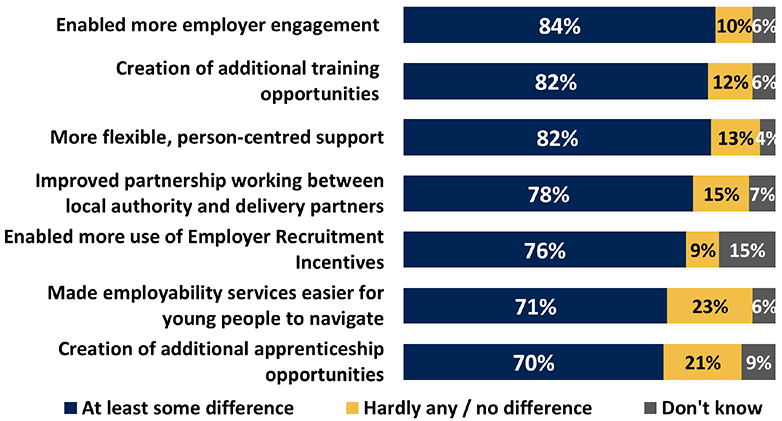
Source: Ipsos survey of employability staff
Base: 112 respondents who think Young Person's Guarantee has made a positive difference
Responses could be provided on a 4pt scale ranging from To a great extent, To some extent, Hardly at all or Not at all
Local authority staff were most likely to say that the Guarantee had made a difference to improved partnership working (87% relative to 78% overall) and more flexible, person-centred support (91% relative to 82% overall). Frontline staff were most likely to say that the Guarantee had made a difference to enabling more employer engagement, improving partnership working and more flexible, person-centred support.
These findings were in line with feedback from interviews and focus groups with stakeholders and staff, which highlighted a range of positive changes to local employment support available to young people due to the Guarantee. This included increased partnership working, greater flexibility, more resources for employers to support young people, increased incentives for employers to take on young people and opportunities to deliver new services. For example, one local authority was now funding a counselling service as part of their employability support for young people which they would have been unable to do so before. Another was offering ERI for the first time, which was creating new opportunities for young people in their area.
One local authority representative described the Guarantee as a "catalyst" for partnership working and problem solving in their area.
"I think it's been a catalyst and it's given us that real, sharp focus. It's brought partners in and everyone has been a bit more willing to share and say, 'Well, look, I've got X amount coming in from such and such, so if we were to put these together, we could then do X, Y and Z.' And that's where it's working really well in that respect."
(Local authority stakeholder)
Feedback on Employer Recruitment Incentives
Local authorities can use some of the funding made available through the Young Person's Guarantee to offer ERIs, which are financial contributions paid to employers towards the costs of recruiting an unemployed young person. Employers were found to be very welcoming of ERIs, highlighting the benefits of having additional resources to support young people and giving them confidence to take on a young person in the first place, knowing that part of their wages would be paid.
"That's a funded post which enables us to free up some money for the mentoring and support of that young person. So without that then, no, we couldn't do it. Or we couldn't do it as well."
(Employer)
"It has made a difference because we're a community interest company. We were concerned, you know, is this viable? So with there being a certain amount for wages, I mean, that definitely helped us."
(Employer)
However, some local stakeholders were less positive about the value and benefit of ERIs, particularly in the current labour market where many employers are struggling to fill vacancies. One local authority was only using them for young people with complex disabilities and support needs who would otherwise struggle to find employment and not offering it to other eligible groups. Another commented that they were unnecessary for most young people who would be able to find work and that they have created an unhelpful expectation amongst some employers that they should be paid to hire young people.
Suggestions for improvement
Employability staff who participated in focus groups shared their views on how they thought services delivered under Young Person's Guarantee could be further developed or improved. The feedback on potential improvements from staff related to:
- More work to raise awareness of the Guarantee amongst employers.
- Using some of the funding to top up young people's earnings to the level of the National Living Wage.
- Provide a travel allowance for those living in rural areas.
- Extend the timescale for support so it is enough to gain qualifications or to provide further support where this is required.
- Greater integration the Young Person's Guarantee with wider services so that similar support is available to young people once they turn 25.
- Better support mechanisms in place for young people who are not kept on by their employer.
Response to the pandemic
Most staff agreed that the Guarantee was the right response to mitigating the impact of the pandemic on young people's progression in learning and work. Almost two thirds (62%) agreed with this, of which 22% strongly agreed. Relatively few disagreed that it was the right response, although one in three (30%) either did not have an opinion (neither agreed nor disagreed) or didn't know (Figure 4.9).

Source: Ipsos survey of employability staff
Base: 156 respondents who are aware of Young Person's Guarantee
Responses could be provided on a 5pt scale ranging from Strongly agree, Agree, Neither agree nor disagree, Disagree or Strongly disagree
Local authority staff and frontline staff were significantly more likely to agree or strongly agree (79% and 69%) that the strategy was the right response to the pandemic, compared to 62% overall.
These findings are in line with the feedback from the interviews and focus groups with stakeholders and staff, who thought that the Guarantee was the right response in principle. However, there were suggestions for how implementation could have been improved at the outset and moving forward. These included timelier and streamlined communications about funding, making funding available earlier and offering young people greater autonomy and choice.
"The YPG funding came far too late. The links in the early stages weren't great. You had different comms people working on YPG as you did on No One Left Behind. I think there's got to be a much more integrated team at the Scottish Government."
(Local authority stakeholder)
"I think the fundamental principle there of a Young Person's Guarantee that says, no matter who you are, wherever you are in Scotland, you have the right to be in work, or an alternative to work, that suits you. I think that's really powerful. I think there is a little bit for me still which is taking that a step further, which is that people should have the right to choose which of those things they'll be in, and we haven't quite done that."
(Third Sector Stakeholder)
There was also a view that, whilst additional support for young people was needed and welcome, there were also a lot of people in older age groups who had been negatively impacted by the pandemic and could have benefited from access to additional resources and support.
"I think it has helped, but I also think the amount of money that was given to young people compared to the amount of money that was set aside for the older was quite substantial, and I think it wasn't just the young people that could have done with the extra money. I think it was the older people as well."
(Local authority stakeholder)
4.4 Engagement with service users
Most employability staff felt that No One Left Behind and the Young Person's Guarantee had made employability services easier for people to navigate and enabled more people to be supported (Figure 4.10).
Figure 4.10: Frontline staff views on accessibility of employability services
- 86% Thought No One Left Behind had enabled more people to be supported
- 69% Thought No One Left Behind had made employability services easier for people to navigate
- 71% Thought Young Persons' Guarantee has made employability services easier for young people to navigate
Base: 96 respondents who think No One Left Behind has made a positive difference; 112 respondents who think Young Person's Guarantee has made a positive difference
Source: Ipsos survey of employability staff
Third sector staff were significantly more likely to say that they thought No One Left Behind had made at least some difference to enabling more people to be supported (95% compared to 86% overall). Third sector and management staff were significantly more likely to say that No One Left Behind had made at least some difference in making services easier to navigate (82% and 76%, compared to 69% overall). Frontline staff were significantly more likely to say that the Young Person's Guarantee had made a difference in making services easier for young people to navigate (88% compared to 71% overall).
Staff described various ways in which local employment services had been made more accessible to certain groups facing particular barriers. For example, one local authority provided IT equipment to individuals living in areas with poor connectivity and driving lessons for people who did not have access to public transport – both funded through Young Person's Guarantee. Another local authority was paying for hotel accommodation to enable service users to attend courses. They welcomed the increased flexibility offered through No One Left Behind and the Guarantee to use funding to address specific barriers faced.
Lack of confidence was widely referenced as a common barrier to engaging with employment services, particularly for young people. Staff have noticed an increase in the prevalence of mental health issues amongst service users since the pandemic, with more people struggling with anxiety which is affecting their confidence when it comes to employability.
"The one that I'm really conscious of, is the ongoing impact of COVID, on the young people coming through who haven't got opportunities when they've finished school. Almost every young person on my caseload at the moment, it's actually hard getting them even onto an employability programme, taking that next step, because they talk about how changed they are as a result of being isolated…"
(Frontline staff member)
The consensus amongst staff was that more could be done to understand and reach people who are not engaging with employability services. Groups mentioned as more difficult to reach or engage include: people dealing with addictions, working parents, young people after they leave school, long-term unemployed, young carers and care leavers. One local authority staff member described how they are trying to understand the extent to which employability services should be delivered at scale or in a more specialised way to reach those who need support most.
"What's the balance between scale and specialism? Should we be redressing that balance and doing less at scale and more intensive work? Albeit you won't reach as many people, but you'll reach the people that have been left behind by these national bigger programmes. It's the bigger picture of things, so I think that's where we'd like to be able to understand and use No One Left Behind as the mechanism for that."
(Local authority stakeholder)
Stakeholders and staff who participated in interviews and focus groups shared their thoughts on how employment services could be further developed to improve accessibility of services in their area. Suggestions included better promotion of services (including in community venues) and better referral pathways between employability services and other services, such as mental health support. Other suggestions included offering more ESOL (English for Speakers of Other Languages) provision, employing frontline staff with lived experience and having a greater focus on establishing meaningful relationships with service users. The key role of the third sector in reaching people who could potentially benefit from employment support was highlighted.
"Many third-sector employability providers don't just do employability, they do youth work, they run community centres, they have other ways to reach people who would benefit from it."
(Third Sector stakeholder)
Contact
There is a problem
Thanks for your feedback